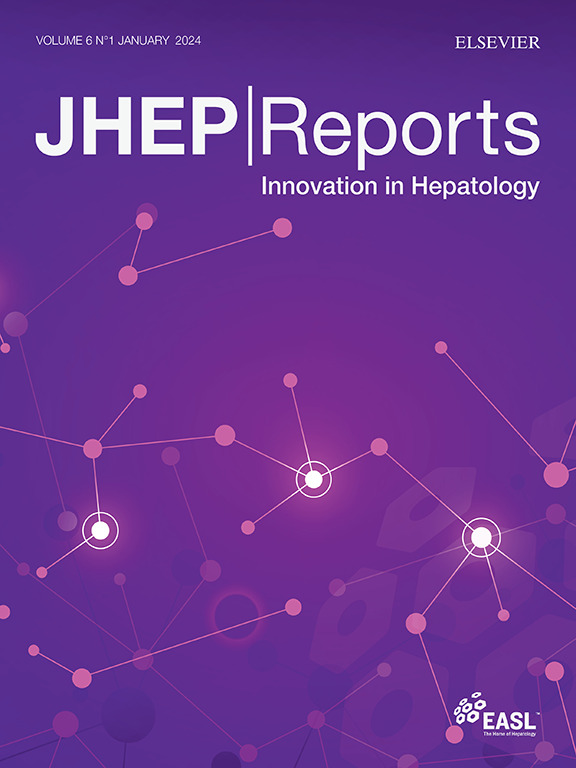Antifibrotic therapies for metabolic dysfunction-associated steatotic liver disease
IF 7.5
1区 医学
Q1 GASTROENTEROLOGY & HEPATOLOGY
引用次数: 0
Abstract
Metabolic dysfunction-associated steatotic liver disease (MASLD) affects more than a quarter of the adult population worldwide. MASLD can progress to metabolic dysfunction-associated steatohepatitis (MASH), which is associated with increased risk of progression to liver fibrosis, cirrhosis and hepatocellular carcinoma, as well as cardiovascular complications. The pathogenesis of MASLD is complex and initiated by altered metabolic signalling circuits between the adipose tissue, muscle, gut and liver. Liver fibrosis is largely driven by the crosstalk of steatotic hepatocytes with macrophages and hepatic stellate cells and constitutes the primary determinant of outcomes in MASLD. Therefore, fibrosis regression is a key therapeutic goal for MASH therapies. Here, we review therapeutic strategies that directly or indirectly reduce liver fibrosis and discuss novel therapeutic concepts. Among these, the targeting of hepatocytes and metabolism have yielded fibrosis reduction in clinical trials and led to the first FDA-approved therapy for MASH. However, these therapies reduce fibrosis only in a subset of patients and have not yet shown benefits beyond the F2-F3 fibrosis stage. Direct antifibrotics and macrophage-based therapies may be more suitable for advanced stages of MASH, but are still in the developmental stage. The arsenal of therapies for MASLD is rapidly expanding and includes macrophage transplantation, hepatocyte-specific oligonucleotides, as well as CAR T cell-based therapies. Integrating these novel therapeutic concepts into stage-specific and/or combination therapies targeting divergent pathogenic mechanisms and cell types is the focus of ongoing research, which may lead to fibrosis reduction in a higher percentage of patients with MASH.

代谢功能障碍相关脂肪变性肝病的抗纤维化治疗
代谢功能障碍相关的脂肪变性肝病(MASLD)影响全球超过四分之一的成年人。MASLD可发展为代谢功能障碍相关脂肪性肝炎(MASH),这与进展为肝纤维化、肝硬化和肝细胞癌以及心血管并发症的风险增加有关。MASLD的发病机制是复杂的,由脂肪组织、肌肉、肠道和肝脏之间的代谢信号通路改变引发。肝纤维化主要由脂肪变性肝细胞与巨噬细胞和肝星状细胞的串扰驱动,是MASLD预后的主要决定因素。因此,纤维化消退是MASH治疗的关键治疗目标。在这里,我们回顾了直接或间接减少肝纤维化的治疗策略,并讨论了新的治疗概念。其中,靶向肝细胞和代谢已经在临床试验中减少了纤维化,并导致了fda批准的首个治疗MASH的疗法。然而,这些疗法仅在一小部分患者中减少纤维化,并且尚未显示出F2-F3纤维化期以外的益处。直接抗纤维化和基于巨噬细胞的治疗可能更适合晚期的MASH,但仍处于发展阶段。MASLD的治疗方法正在迅速扩大,包括巨噬细胞移植、肝细胞特异性寡核苷酸以及基于CAR - T细胞的治疗。将这些新的治疗概念整合到针对不同致病机制和细胞类型的阶段特异性和/或联合治疗中是正在进行的研究的重点,这可能导致更高比例的MASH患者纤维化减少。
本文章由计算机程序翻译,如有差异,请以英文原文为准。
求助全文
约1分钟内获得全文
求助全文
来源期刊

JHEP Reports
GASTROENTEROLOGY & HEPATOLOGY-
CiteScore
12.40
自引率
2.40%
发文量
161
审稿时长
36 days
期刊介绍:
JHEP Reports is an open access journal that is affiliated with the European Association for the Study of the Liver (EASL). It serves as a companion journal to the highly respected Journal of Hepatology.
The primary objective of JHEP Reports is to publish original papers and reviews that contribute to the advancement of knowledge in the field of liver diseases. The journal covers a wide range of topics, including basic, translational, and clinical research. It also focuses on global issues in hepatology, with particular emphasis on areas such as clinical trials, novel diagnostics, precision medicine and therapeutics, cancer research, cellular and molecular studies, artificial intelligence, microbiome research, epidemiology, and cutting-edge technologies.
In summary, JHEP Reports is dedicated to promoting scientific discoveries and innovations in liver diseases through the publication of high-quality research papers and reviews covering various aspects of hepatology.
 求助内容:
求助内容: 应助结果提醒方式:
应助结果提醒方式:


